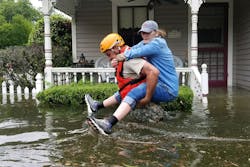How Cities and the Military Can Join Forces to Improve Resilience, Add Microgrids
In an iconic photo from last August’s Hurricane Harvey, a national guardsman in near waist-high flood waters carries a woman to safety on his back. The photo depicts a common thread found in disaster rescue – the military are called.
So it makes sense that today’s movement to improve urban resilience – and add microgrids – looks to the military as a natural ally. Such is the case in a new report issued by 100 Resilient Cities, a Rockefeller Foundation organization created to help urban areas withstand the stresses of the 21st century.
“Safer and Stronger Cities: Strategies for Advocating for Federal Resilience Policy” offers a menu of activities to engage the federal government more closely in resilience efforts, among them creation of defense-city partnerships.
The idea is for cities to coordinate with nearby military bases in building new infrastructure, “focusing on mutually beneficial investments that enhance preparedness and reduce losses from natural disasters,” says the report.
Join us at Microgrid Knowledge for Microgrid 2019: Shaping the New Electric Grid, May 14-16 in San Diego
Microgrids are a natural fit for this kind of partnership. It’s a technology being pursued separately by both cities and the military, but for similar reasons. Both desperately need power to restore normalcy and protect the citizenry in a disaster. And both are leaders in greening U.S. energy supply.
In fact, examples already exist of the military and communities engaging in such partnerships – although not under the formal name proposed in the report: the DOD-City Infrastructure Resilience Partnership.
As the report points out, the Department of Defense is collaborating with Oahu, the third largest of Hawaii’s islands, on a microgrid at the Schofield Barracks Generating Station. The project will provide power for customers of Hawaii Electric Company during normal operations. But during an emergency, the plant can island – separate from the utility grid – and serve the base. The utility will own and operate the plant on land leased from the Army, a coveted location because it is inland so not vulnerable to coastal flooding.
Because the Defense Department has been engaged in an effort to bring energy independence to its facilities, it has several additional military microgrids either operating or in development. In California, a sophisticated microgrid at the Marine Corps Air Station Miramar San Diego is scheduled to be finished in the second quarter of 2018. Some others are:
- A 10 MW military microgrid complex on Parris Island, developed under a $91.1 million energy savings performance contract through the Naval Facilities Engineering and Expeditionary Warfare Center
- The U.S. Army Garrison Kwajalein (USAG-KA) microgrid in the Marshall Islands with a 2.4-MW solar photovoltaic system and a 2 MW/3-MWh of energy storage
- The Redstone Arsenal in Alabama, which operates a solar and energy storage facility that is designed to be easily upgraded to a microgrid
- A U.S. Air Force renewable energy microgrid being built on Wake Island in the North Pacific Ocean
- A 7-MW military microgrid at the Indiana National Guard’s Camp Atterbury training operation center in Johnson County
- A 10-MW military microgrid in the California city of Twentynine Palms that is undergoing a $7.8 million expansion as part of long-term plan to achieve energy independence
- A 25-MW microgrid for the Marine Corps Air Station (MCAS) Yuma built in partnership with Arizona Public Service.
- Several temporary microgrids in Puerto Rico installed by the Army Corps of Engineers post Hurricane Maria
Many cities – or their utilities — also are pursuing microgrids, among them Boston, Boulder, Chicago, Los Angeles, Pittsburgh and New York.
Next steps? The 100 Resilient Cities report recommends dialogue between communities, the Defense Department and Army Corp. It calls for project funding through Homeland Security and Congressional authorization of the new DOD-City Infrastructure Resilience Partnership under the National Defense Authorization Act.
About the Author
Elisa Wood
Editor-in-Chief
Elisa Wood is the editor and founder of EnergyChangemakers.com. She is co-founder and former editor of Microgrid Knowledge.
